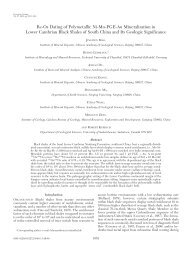Metallogeny of Granite-Related Rare-Metal Mineralization
Metallogeny of Granite-Related Rare-Metal Mineralization
Metallogeny of Granite-Related Rare-Metal Mineralization
Create successful ePaper yourself
Turn your PDF publications into a flip-book with our unique Google optimized e-Paper software.
388 B. LEHMANN<br />
tional crystallization in the igneous evolution <strong>of</strong> the<br />
rock suites discussed is the multiphase nature <strong>of</strong> the<br />
intrusion systems and their systematic enrichment in<br />
incompatible trace elements and complementary<br />
depletion in compatible components towards the<br />
youngest and volumetrically smallest phases. This<br />
situation is well documented for the granite suites<br />
from the Erzgebirge (TrscHENoonn et al., 1987),<br />
Massif Central (Aunrnr, 1966), and SE Asia<br />
(CoeuNci et al., 1986), and points to a crystallization<br />
process from the plutonic margins inwards and<br />
episodic tapping <strong>of</strong> an increasingly fractionated and<br />
buoyant magma chamber below the gradually deepening<br />
solidification front.<br />
HYDROTHERMAL REDISTRIBUTION<br />
The magmatic chemical inventory <strong>of</strong> high-level<br />
granitic rocks is invariabiy affected both by residual<br />
aqueous fluids <strong>of</strong> magmatic origin and by ingressing<br />
meteoric and formation water. The metasomatic<br />
effect <strong>of</strong> hydrothermal overprint on trace-element patterns<br />
in rocks depends on the reaction progress <strong>of</strong><br />
fluid-rock interaction. Tantalum and, to a lesser<br />
degree also titanium, are relatively immobile in most<br />
granite-related hydrothermal systems which is why<br />
the whole-rock abundances <strong>of</strong> these two elements can<br />
be used as an approximative indicator <strong>of</strong> magmatic<br />
fractionation in a given granite sample (Figs. 5-11).<br />
Titanium is used for those sample suites for which little<br />
or no Ta data are available.<br />
Distribution patterns <strong>of</strong> Sn as a function <strong>of</strong> Ta<br />
or Ti are shown in Figures 5-7. These patterns reflect<br />
both a magmatic tin enrichment trend and hydrothermal<br />
redistribution <strong>of</strong> variable degree. Relatively little<br />
tin redistribution is indicated for the Erzgebirge and<br />
N{assif Central suites (Fig. 5), which give good linear<br />
correlation trends in log-log space, suggestive <strong>of</strong> element<br />
control dominantly by magmatic processes, i.e.<br />
fractional crystallization, as also deduced from the<br />
Ta-Ti plot <strong>of</strong> Figure 2. It should be noted, however,<br />
that the invariable scatter in such logarithmic plots<br />
allows the identification <strong>of</strong> hydrothermal effects only<br />
when they are very pronounced with a more than<br />
about 100% change in element content. Compared to<br />
the Erzgebirge and Massif Central suites, there is a<br />
distinct increase in degree <strong>of</strong> scatter for the Bolivian<br />
(Fig. 6) and the Thailand/Burma rock suites (Fig. 7).<br />
The Thailand/Burma example gives a very pronounced<br />
scatter for the most fractionated sample populations<br />
from the tin-tungsten mineralized Pilok and<br />
Hermyingyi aplogranite stocks, with the additional<br />
feature <strong>of</strong> a general tin deficiency when compared to<br />
the more or less magmatic tin enrichment trend <strong>of</strong> the<br />
Erzgebirge reference rock suite. This large-scale tin<br />
1 0000<br />
't<br />
1000:<br />
: 1<br />
, . } l<br />
tr<br />
l i -<br />
O. 1nn-l<br />
( n l<br />
" l<br />
10<br />
o # *<br />
1 10 100 1000<br />
Ta (ppm)<br />
Fig. 5 Ta-Sn variation diagram for granitic rock samples<br />
from the northern Massif Central in France and the Erzgebirge<br />
granite reference suite. For data sources see Fig.<br />
4.<br />
ts<br />
q<br />
n<br />
Uf<br />
I<br />
--:<br />
l I - _.1 A a o t<br />
^ ^ a<br />
*<br />
A<br />
e<br />
a<br />
BU LK<br />
CRUST<br />
A<br />
O a o<br />
a<br />
o<br />
+ _<br />
" * * t<br />
ö<br />
* +<br />
.5a^<br />
+<br />
^<br />
+ ^<br />
1 10<br />
Ta (ppm)<br />
Beouvoir<br />
rt^..A- /Q ^^ I<br />
A<br />
: +<br />
t r c<br />
a Cordillera Reol<br />
r Choi lo Mine<br />
c Quimso Cruz<br />
* Mocusonl<br />
O Los Froiles<br />
O Morococo lo<br />
. N Chile<br />
+ Erzgebirge<br />
Fig. 6 Ta-Sn variation diagram for granitic and rhyolitic<br />
rock samples from the Bolivian tin province and its surroundings.<br />
For data sources see Fig. 2. Data point A<br />
locates the composition <strong>of</strong> the Altenberg tin porphyr-v in<br />
the Erzgebirge.<br />
deficiency characterizes several <strong>of</strong> the SE Asian tin<br />
granite systems and is seen as a complementary<br />
feature <strong>of</strong> small-scale tin-ore deposition in the same<br />
system (LEuntaNN and Masawe'r, 1989). The reason<br />
for the very pronounced tin redistribution patterns in










